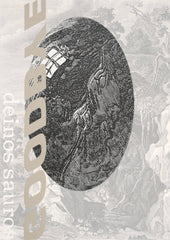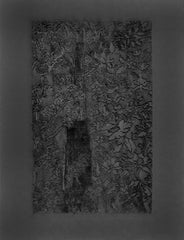About the edition
This laser-engraved woodblock print was created in DCA Print Studio as part of our DCA Editions programme to coincide with Alberta Whittle's exhibition How Flexible Can We Make the Mouth in DCA galleries.
Alberta’s work lays out a new visual and oral language that questions accepted Western constructs of history. Her research is at all times undertaken with an acute understanding of how formal historical records produced by privileged white men have always sought to replace more ancient and informal means of comprehending the past. Eoin Dara, DCA Head of Exhibitions
Alberta Whittle’s conversations about this work began with the publication 1492 What Is It Like to Be Discovered? (Small and Jaffe, 1992). This compilation of poems, unattributed texts and appropriated artwork includes adaptations of a series of 16th Century engravings by Theodore de Bry, whose work illustrates the arrival of Columbus in the Americas and European colonists’ brutal and unjust claiming of a so-called 'New World.'
Using an array of analogue and digital processes, Whittle overlays interconnecting narratives to create a story in print: Beginning with colours drawn from her gallery recreation of a subsiding Barbadian Chattel house, she juxtaposes a series of colour combinations from her childhood to create the backdrop for the scene.
The central imagery, drawn from the de Bry engravings, is created with laser-engraved woodblocks, inverted and transposed, creating deliberately hard-to-read areas in depictions of Columbus’s first arrival and subsequent violent suppression of indigenous peoples. These not only recall the 16th Century prints but, through the process of cutting into and gradual removal of the wood, also evoke Whittle’s memories of the material impermanence of living in Barbados, where wooden furniture, housing, even books, may gradually erode due to invasive woodworm or corrosive salt air.
The final prints are embossed with a shimmering gold snail trail - a hard, fleshy form, impressed upon the bodies of the invaders within the scene. Speaking of the invasive, giant African snails in her home town, Whittle chose to incorporate the saline traces left by snails as they travelled. Superimposed on this narrative these trails recall the concepts of ‘slippage’ and transience in Whittle’s wider work, alongside the more literal wetness and saltiness of the sea, migration, and voyaging sailors. The gold ink on the surface of this story reminds us of the ever present role of trade, wealth and power in such histories.
Related Work
Part of a suite of three prints:
- Secreting Myths (golden yellow)
- Secreting Myths (magenta)
- Secreting Myths (jade)
| Year | 2019 |
| Edition of | 11 |
| Media | Laser-engraved woodblock print on Somerset Satin 300gsm paper |
| Dimensions | 56 x 69cm |
| Signature | Signed and numbered by artist on verso |
About Alberta Whittle
Alberta Whittle (b.1980, Bridgetown, Barbados) lives and works in Glasgow. Her practice-led research involves performance, writing, digital collage and video installation. Whittle received her MFA from Glasgow School of Art in 2011 and she is a PhD candidate at Edinburgh College of Art. Whittle was also the 2018 recipient of The Margaret Tait Award. Whittle’s work has been exhibited in various solo and group shows within institutions including the 13th Havana Biennial, Cuba (2019), GoMA, Glasgow (2019), The City Arts Centre, Edinburgh (2019), The Showroom, London (2018), National Art Gallery of the Bahamas (2018), RAW Material, Dakar (2018), FADA Gallery, Johannesburg (2018), the Apartheid Museum, Johannesburg (2017), FRAMER FRAMED, Amsterdam (2015), Goethe On Main, Johannesburg (2015), at the Johannesburg Pavilion at the 56th Venice Biennale, Venice (2015), and BOZAR, Brussels (2014).
Pick up in Store
If you would like to buy online and then collect your edition at DCA, please select the Pick up option at checkout. We will then be in touch to arrange a convenient collection time with you.



